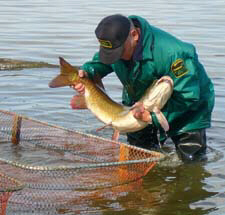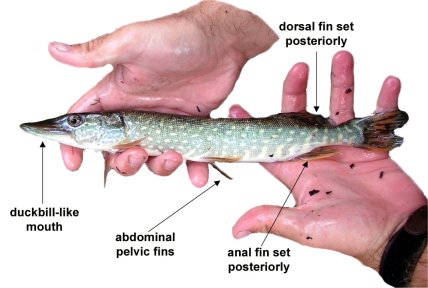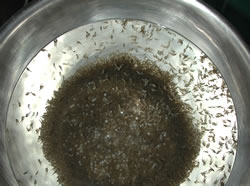
Would you like Frys with that?
Muskellunges have very specific spawning
schedules. They must begin when the temperature is somewhere between 50
and 60 degrees Fahrenheit, so this usually happens around mid-April
or into the beginning of May and only spawn for 5 to 10 days. The
females will lay eggs (as many as 200,000) along mucky bottoms of lakes or in weed beds.
The depths can have a drastic range (up to 6 feet), however they are most commonly
found in shallow waters. Ironically, the males will arrive early at the
spawning beds raring to go, however they must wait on the females to
deliver the eggs. Fertilization occurs out side of the body, so very
little physical contact
 actually goes on. However, some males like it rough. After
releasing their milt (sperm) the males will violently thrash their
tails over where the eggs lie. This is done to spread out the milt
in attempts to fertilize as many eggs as possible. Some males get so
rough that they can cause lacerations to their tails. These cuts in
their skin can lead to an infection and eventually death by
lymphosarcoma. However, no wham-bam-thank you ma'am for
the males. They
tend to stick around in the weed bed for a few days afterword. It is
unsure whether they do this to protect the eggs, or wait for another
female to arrive with her eggs. Another unique aspect to Muskellunge
mating is that males and females have been documented to spawn in
the same weed bed every year. After around 4 years
actually goes on. However, some males like it rough. After
releasing their milt (sperm) the males will violently thrash their
tails over where the eggs lie. This is done to spread out the milt
in attempts to fertilize as many eggs as possible. Some males get so
rough that they can cause lacerations to their tails. These cuts in
their skin can lead to an infection and eventually death by
lymphosarcoma. However, no wham-bam-thank you ma'am for
the males. They
tend to stick around in the weed bed for a few days afterword. It is
unsure whether they do this to protect the eggs, or wait for another
female to arrive with her eggs. Another unique aspect to Muskellunge
mating is that males and females have been documented to spawn in
the same weed bed every year. After around 4 years
 Muskellunge fry
(youths) can begin to sexually mature. Muskellunges can live as long
as 20 years.
Muskellunge fry
(youths) can begin to sexually mature. Muskellunges can live as long
as 20 years.
However because of the demand and popularity of Muskellunge
they are now mostly stocked into lakes. This is to increase the
overall population in lakes, and to increase the average size.
Another artificial interference to Muskellunge reproduction are the
presence of Tiger Muskellunges (Esox Masquinongy X
Esox
lucius ).
This is a sterile hybrid of Muskellunge and Northern Pike (Esox
lucius). Tiger Muskellunges are usually smaller than true
Muskellunges, however not by much. These animals are bred in fish
hatcheries and released into lakes all across the Midwest. These
organisms are also used to scout out potential new habitats for true
Muskellunges. Because they are similar to a Muskellunge, they should be
able to handle the same environments. States like California have
attempted to get a Muskellunge population, however most recent
stocking attempts failed. Also, because
 Muskellunge natural
reproduction is so hit or miss, some states group lakes into
categories or zones due to the Muskellunge reproduced to stocked
ratio. A Category 1 lake is one where no stocking is needed. These
lakes are very rate. Category 2 lakes are also relatively rare,
because in these lakes the Muskellunge population can support
itself, however they are still stocked to help the population. The
Category 3 lakes are ones where no reproduction of Muskellunges is
seen to occur. The Muskellunge population in these lakes is strictly
from stocking. Category 4 is similar, except these lakes are not
stocked with Muskellunges, but Tiger Muskellunges.
Muskellunge natural
reproduction is so hit or miss, some states group lakes into
categories or zones due to the Muskellunge reproduced to stocked
ratio. A Category 1 lake is one where no stocking is needed. These
lakes are very rate. Category 2 lakes are also relatively rare,
because in these lakes the Muskellunge population can support
itself, however they are still stocked to help the population. The
Category 3 lakes are ones where no reproduction of Muskellunges is
seen to occur. The Muskellunge population in these lakes is strictly
from stocking. Category 4 is similar, except these lakes are not
stocked with Muskellunges, but Tiger Muskellunges.
The meager fossil evidence for Muskellunge shows that they
arose in the Miocene epoch, of the Neogene period. It was long
believed that Muskellunges were just evolved Northern Pike, however
we now know they evolved independently of Northern Pike. Find out
how Muskellunges have
evolved to dominate their ecosystem.